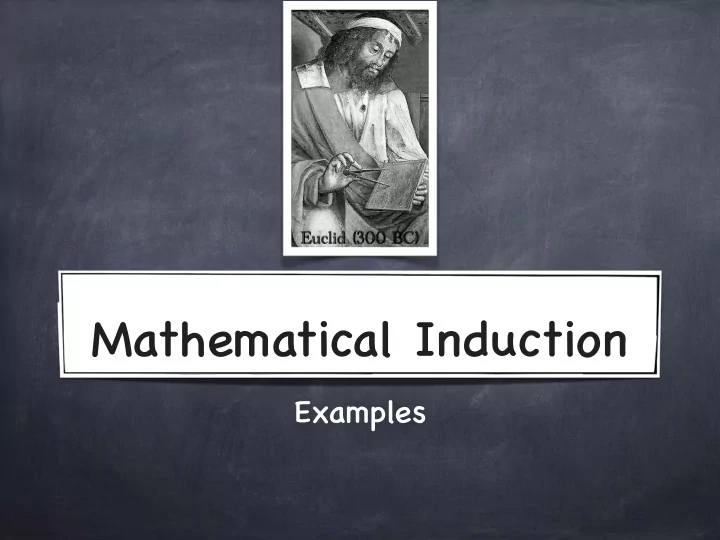

Euclid (300 BC) Mathematical Induction Examples
Strong Induction Induction hypothesis: ∀ n ≤ k P(n) To prove ∀ n ∈ Z + P(n): we prove P(1) (as before) and that ∀ k ∈ Z + (P(1) ∧ P(2) ∧ ... ∧ P(k)) → P(k+1) P(1) P(1) → P(2) Mathematical Induction ∧ P(2) P(1) ∧ P(2) → P(3) The fact that for any n, ∧ we can run this procedure to P(1) ∧ .. ∧ P(3) → P(4) P(3) generate a proof for P(n), and ∧ P(1) ∧ .. ∧ P(4) → P(5) P(4) hence for any n, P(n) holds. ∧ P(1) ∧ .. ∧ P(5) → P(6) P(5) : ∧ : ∀ n ∈ Z + P(n)
Postage Stamps Claim: Every amount of postage that is at least ₹ 12 can be made from ₹ 4 and ₹ 5 stamps i.e., ∀ n ∈ Z + n ≥ 12 → ∃ a,b ∈ N n=4a+5b Base cases: n=1,..,11 (vacuously true) and n = 12 = 4 ⋅ 3 + 5 ⋅ 0, n = 13 = 4 ⋅ 2 + 5 ⋅ 1, n = 14 = 4 ⋅ 1 + 5 ⋅ 2, n = 15 = 4 ⋅ 0 + 5 ⋅ 3. Induction step: For all integers k ≥ 16 : Strong induction hypothesis: Claim holds for all n s.t. 1 ≤ n < k To prove: Holds for n=k k ≥ 16 → k-4 ≥ 12. So by induction hypothesis, k-4=4a+5b for some a,b ∈ N . So k = 4(a+1) + 5b.
Prime Factorization Need some more work to Every positive integer n ≥ 2 has a prime factorization show unique i.e, n = p 1 ⋅ ... ⋅ p t (for some t ≥ 1) where all p i are prime factorization. p prime ∧ p|ab Base case: n=2. (t=1, p 1 =2). → p|a ∨ p|b Induction step: (Strong) induction hypothesis: for all n ≤ k, ∃ p 1 ,...,p t , s.t. n= p 1 ⋅ ... ⋅ p t To prove: ∃ q 1 ,...,q u (also primes) s.t. k+1= q 1 ⋅ ... ⋅ q u Case k+1 is prime: then k+1=q 1 for prime q 1 Case k+1 is not prime: ∃ a ∈ Z + s.t. 2 ≤ a ≤ k and a|k+1 (def. prime). i.e., ∃ a,b ∈ Z + s.t. 2 ≤ a,b ≤ k and k+1=a.b (def. divides; a ≥ 2 → a.b > b) Now, by (strong) induction hypothesis, both a & b have prime factorizations: a=p 1 ...p s , b=r 1 ...r t . Then k+1=q 1 ...q u , where u=s+t, q i = p i for i=1 to s and q i = r i-s , for i=s+1 to s+t.
Be careful about ranges! Claim: Every non-empty set of integers has either all elements even or all elements odd. (Of course, false!) “Proof” (bogus): By induction on the size of the set. Base case: |S|=1. The only element in S is either even or odd ✓ Bug: Induction hypothesis cannot be Induction step: For all k > 1, bootstrapped from the base case Induction hypothesis: suppose all non-empty S with |S| = k, has either all elements even or all elements odd. To prove: then, it holds for all S with |S|=k+1. Let S = {a,b} ∪ S’, where |S’|=k-1. (Note: S’ is not empty) By IH, S’ ∪ {a} has all even or all odd. Say, all even. Then S’ is all even. Now, S’ ∪ {b} is also all even or all odd. Since S’ not empty, it is all even. Thus S = S’ ∪ {a,b} is all even. QED.
Be careful about ranges! Claim: Every non-empty set of integers has either all elements even or all elements odd. (Of course, false!) “Proof” (bogus): By induction on the size of the set. We proved P(1) and ∀ k>1 P(k) → P(k+1) P(1) P(2) → P(3) P(3) → P(4) P(4) → P(5) P(5) → P(6) :
Nim Alice and Bob take turns removing matchsticks from two piles Initially both piles have equal number of matchsticks At every turn, a player must choose one pile and remove one or more matchsticks from that pile Goal: be the person to remove the last matchstick Claim: In Nim, the second player has a winning strategy (Aside: in every finitely-terminating two player game without draws, one of the players has a winning strategy) Claim: The following is a winning strategy for the second player: keep the piles matched at the end of your turn
Nim Claim: The following is a winning strategy for the second player: keep the piles matched at the end of your turn Induction variable: n = number of matchsticks on each pile at the beginning of the game. Base case: n=1. Alice must remove one. Next, Bob wins. ✔ strong Induction step: for all integers k ≥ 1 Induction hypothesis: when starting with n ≤ k, Bob always wins To prove: when starting with n=k+1, Bob always wins Case 1: Alice removes all k+1 from one pile. Next, Bob wins. Case 2: Alice removes j, 1 ≤ j ≤ k from one pile. After Bob’ s move k+1-j left in each pile. By induction hypothesis, Bob will win from here.
Recommend
More recommend